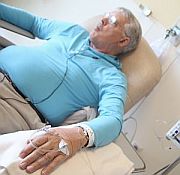Regardless of chemo intensity, palliative care, hospice rarely used with acute myeloid leukemia
WEDNESDAY, Sept. 2, 2015 (HealthDay News) — Older patients with acute myeloid leukemia (AML) are intense users of health care services and rarely use palliative care and hospice services, according to a study published in the August issue of Cancer.
Areej R. El-Jawahri, M.D., from Massachusetts General Hospital in Boston, and colleagues retrospectively analyzed health care utilization and end-of-life care in 330 consecutive older patients diagnosed with AML between May 1, 2005, and December 23, 2011.
The researchers found that the median number of hospitalizations for the entire cohort was 4.2. For patients who died, 28.3 percent of their life after diagnosis was spent in the hospital and 13.8 percent attending outpatient clinic appointments. Over two years of follow-up, the majority of patients (87.9 percent) died, although only a minority received palliative care (16.2 percent) or hospice (23.1 percent) services. Sixty-one percent died in the hospital. Patients who received intensive induction therapy (cytarabine/anthracycline combination versus single-agent therapy) and who ultimately died spent 30 percent more of their life after diagnosis in the hospital (P < 0.0001) and were less likely to receive hospice services (odds ratio, 0.45; P = 0.05).
“The current findings highlight the intensity of health care utilization among older patients with AML, regardless of treatment modality,” the authors write.
Several authors disclosed financial ties to the pharmaceutical industry.
Copyright © 2015 HealthDay. All rights reserved.








